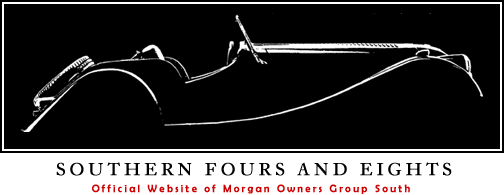This Is Why The Plus 4 Is Our Favorite Modern Morgan (https://petrolicious.com)
The Morgan Plus 4 has been around since 1950, and on the surface not a lot has changed. The body is still rich in curves and chrome, the front wings still span two thirds of the car’s length, the wheels are still spoked and the roof still comes down via manpower rather than electricity. But don’t let that fool you into thinking the Morgan Plus 4 is a relic. It’s not, as I set out to prove by liberating one from the factory for an all too brief three-day fling.

During my time as a motoring writer, I’ve been lucky enough to drive everything that Morgan has to offer. I’ve enjoyed the cheek and charm of the 4/4 – the Plus 4’s little brother. I’ve covered many a happy mile in the Plus 4’s big brother, the 3.7 V6 Roadster. I’ve giggled like a fool while piloting the modern 3 Wheeler, and I’ve used far too much fuel listening to the V8 soundtrack that accompanies the Morgan Aero cars. But out of them all, it’s the Plus 4 that has won my heart.
If I’m ever in the fortunate position to be able to afford a Morgan, this is the one.
The 4/4 is charming, but the 1.6-liter petrol engine is hardly a thrill. The 3 Wheeler I adore, but it’s a fair weather car, and sometimes in the UK that means a “two days out of the year” car. The Roadster with its 3.7 V6 is too wild for me, too “on” all the time, if you will. As for the V8 cars, I love them, but they just don’t have the draw of the traditional steel chassis Morgans, at least not for me.
The Plus 4 is pretty much perfect in my eyes. It has an eager-to-please personality that the others miss in the pursuit of trying to be too much of one thing or another. In a nutshell, it’s the perfect all-rounder. At least in the context of a two-seater, open-top sports car, that is.
The Plus 4 came about because the 4-4 (that’s not a typo, it later became the 4/4) wasn’t satisfying those buyers looking for a bit more pace. This was still well before the days of the Plus 8 with its thumping eight-cylinder, and the V6 Roadster wasn’t even a twinkle in Peter Morgan’s eye at the time either. The 4-4 was Morgan’s main offering then, so if it didn’t please a customer, there was nothing else to sell them. They would go and buy from another brand.

To address matters, Morgan put a 2,088cc four-cylinder engine from a Standard Vanguard into a slightly longer 4-4 chassis and offered that to the purchasing public. It worked to retain those strayed to other sports cars options, and ever since then, the Plus 4 has been a mainstay of the Morgan range. Over the years it has seen many engines in its bay, but it’s always been a 2.0 (or thereabouts), and it has always stood its ground as a staple in the lineup as the 4/4’s bigger sibling.
This, the most modern version, is powered by a 1,999cc Ford GDI engine mated to a five-speed manual sourced from Mazda. It boasts all the modern niceties you’d want like twin cams and fuel injection, and the unit is good for 154bhp at 6,000rpm. As for torque, you’ve got 148lb/ft. I know, those two numbers don’t look too astonishing on paper. It’s the inclusion of a third that brings the fun: the weight. And the Plus 4 tips the scales at just 2,044lb. That makes things much more interesting.
And while it may indeed have a modern source of propulsion, there is nothing modern about the way it drives. But that’s not a bad thing—no one buys a Morgan to ride on the cutting edge. In our fly-by-wire world, it’s nice to have a heavy clutch and a firm brake pedal. The steering may be assisted, but you wouldn’t necessarily know it. It’s heavy, in the way that results in feedback and a more direct connection to how the car’s interacting with the road. You have to drive this car and feel every tiny mistake you make along the way—it won’t hide things from you with trick adaptive suspension or swaddling comfort. It’s not easy to drive the Morgan fast like it is in so many modern assisted sports cars, but if you commit to it, if you work through it, it is oh so very rewarding to get it on the edge.
The engine hauls the Plus 4 along with impressive urgency for such a small naturally aspirated lump, and its an eager little thing throughout the range. Were it not for the factory-fitted Yokohama rubber, oversteer might be an issue even. It’s not though, at least on the right rubber, and grip is plentiful here. In fact, hit the gas too hard off the line and your spine is thanked with a punch from the tramping rear axle you’re essentially perched on top of.
The Morgan Plus 4 is a car that demands your respect and expects you to learn. If you just get in and try to drive it like you would any other sports car, you probably won’t enjoy it. You may even find it hard and unrewarding work. Bond with it though, give it some miles and some time spent getting used to the chassis, and I bet you’ll fall for it.
The cockpit while relatively spartan, is finished in beautiful, comfortable leather, and the detail in the fitting and stitching is astounding. The Moto Lita steering wheel is tactile and inviting. You want both hands on it at all times. The gear shift is slick and mechanical, direct and sure. You notice changing gears with this setup, rather than losing the action to autopilot as you would in another car. Then there’s the bunched up, race-style pedal box with floor-mounted hinges. It reminds you from the first stab of the clutch on startup that you’re not driving the normal or the mundane today.
It’s not inconveniently sporty to ride in though, and it’s quite comfortable; with the roof up for instance, I still fit inside easily, which being 6’3” isn’t always the case. There’s even a trick, modern stereo, but fear not, no infotainment iPads to be found here.
December 14, 2017
